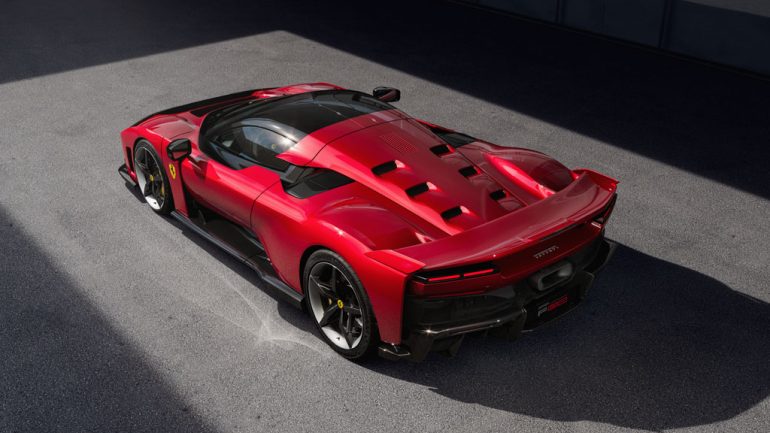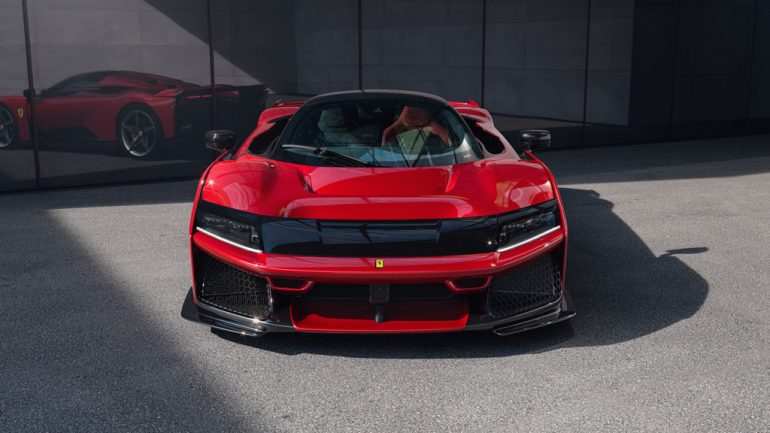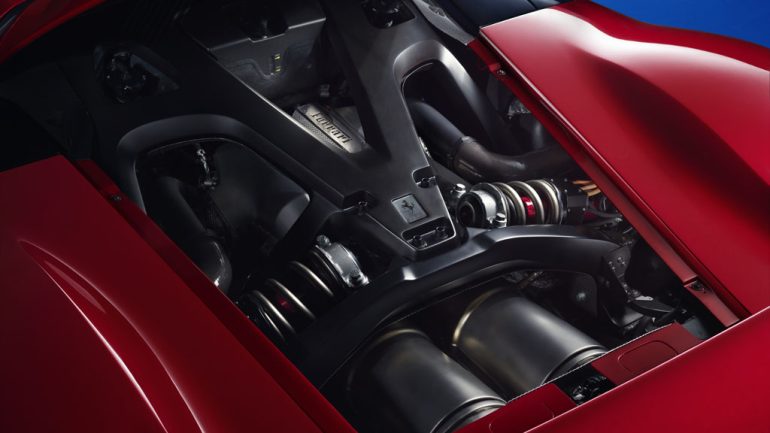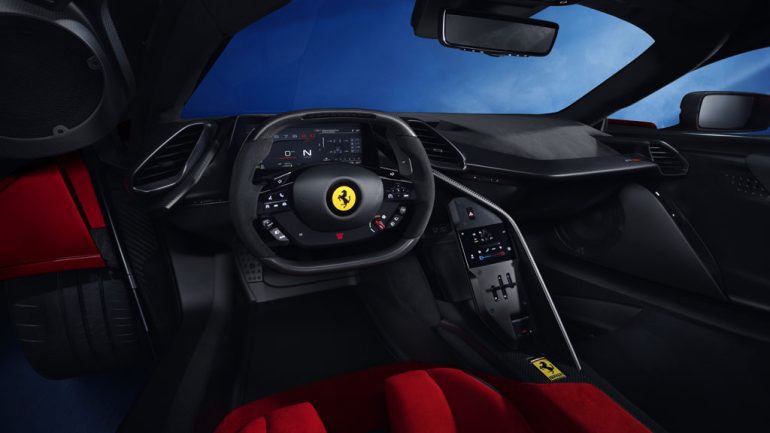
Ferrari’s legacy in the hypercar segment is iconic. Now, more than a decade after the launch of the LaFerrari, the automaker is back with a new flagship—the Ferrari F80. This vehicle doesn’t just aim to be fast; it’s engineered to reshape what’s possible in the world of hypercars.
The Ferrari F80 sports an unprecedented powertrain. Instead of the traditional V12, Ferrari has opted for a 3.0-liter hybrid V6. This move cuts engine weight without sacrificing power. Alone, the V6 produces 900 hp. Combined with three electric motors, the F80 boasts an astonishing 1,184 hp—making it the most powerful Ferrari ever.
Also, don’t forget that you can get discounted new car pricing with a free quote through qualified local dealer partners.

It rockets from 0 to 62 mph in just 2.15 seconds, and hits 125 mph in 5.75 seconds. Its top speed is 217.5 mph, slightly outpacing the new McLaren W1.

This isn’t just any V6. Ferrari took the core engine from the 296 GTB and heavily modified it. The V6 features a 120-degree, hot-V layout, much like the one found in Ferrari’s 499P Le Mans racer. Ferrari improved the combustion process and enhanced ignition timing, which, combined with higher-pressure chambers, boosts performance while maintaining the engine’s weight.

An eight-speed dual-clutch transmission ensures smooth shifts, while electric turbos reduce lag. The V6 can hit a screaming 9,000 rpm, with a limiter set at 9,200 rpm for extra thrill.
Ferrari engineered its electric motors in-house, equipping the F80 with three—two on the front axle and one on the rear. The front motors not only provide extra torque but enable torque vectoring, enhancing cornering precision. With regenerative braking, they can send up to 210 kW of energy back to the battery.

The rear motor handles several tasks: starting the V6, energy recovery, and delivering extra torque when needed. All motors are powered by an 800-volt lithium battery, offering a combined output of 325 hp and a 70 kW regenerative capacity.

Ferrari designed the F80’s monocoque chassis using carbon fiber and composite materials to reduce weight without compromising strength. The asymmetrical design offers unique functionality, with an adjustable driver’s seat (unlike many fixed supercar designs), and butterfly doors that enhance both practicality and style.
Aerodynamics are central to the F80’s design. Inspired by Formula 1, Ferrari integrated a pointed nose and S-Duct for 1,014 pounds of downforce on the front end alone. Add the massive rear diffuser and active aero wing, and the F80 achieves 2,204 pounds of total downforce at 155 mph, matching the McLaren W1’s performance.

Ferrari offers three driving modes: Hybrid, Performance, and Qualify. Hybrid mode focuses on maximizing energy recovery, while Performance maintains a 70% battery charge for aggressive driving. Qualify mode unlocks the car’s full potential, unleashing all 1,184 hp.

One of Ferrari’s most exciting new features is Boost Optimization. This system learns track layouts and deploys additional power strategically during fast sections, ensuring maximum performance.
Stopping power is just as crucial as speed. Ferrari collaborated with Brembo to create CCM-R Plus brakes, offering 100% more strength and 300% better heat dissipation than standard carbon fiber brakes. This ensures reliable braking even at extreme speeds.

The F80 also uses a sophisticated active suspension system based on Multimatic’s spool-valve dampers. This setup eliminates the need for anti-roll bars, offering improved handling and ride comfort while maintaining aerodynamics.
Only 799 units of the F80 will be produced, with deliveries starting in late 2025. Buyers can choose between Michelin Pilot Sport Cup 2 or 2R tires, depending on driving preferences. Active safety features such as automatic emergency braking, lane-keeping assist, and traffic sign recognition are available—a rarity in this class of vehicle.

The F80 comes at a premium price of €3.6 million (around $4 million USD), making it Ferrari’s most expensive car to date, and twice the price of the McLaren W1.

The Ferrari F80 is more than just a powerful hypercar—it’s a technological masterpiece. With its hybrid V6, advanced aerodynamics, and cutting-edge braking and suspension systems, it sets new standards for performance and innovation. As Ferrari moves forward, the F80 shows that the brand is not just evolving but leading the future of hypercars.
Will this car further solidify Ferrari’s dominance in the hypercar segment? All signs point to yes.
Ferrari F80 – Technical data sheet
ENGINE
INTERNAL COMBUSTION ENGINE (ICE)
Type V6 – 120° – dry sump
Total displacement 2992 cc
Bore and stroke 88 mm × 82 mm
Maximum power** 900 cv at 8750 rpm
Maximum torque 850 Nm at 5550 rpm
Maximum engine speed 9000 rpm (dynamic limiter at 9200 rpm)
Compression ratio 9.5:1
Specific power output 300 cv/l
HYBRID POWERTRAIN
Type Concentrated winding stator, Litz wire and stator and rotor in a Halbach array configuration
REAR ELECTRIC MOTOR (MGU-K)
Operating voltage 650 – 860 V
Peak power Regenerative braking: 70 kW (95 cv); ICE assist: 60 kW (81 cv)
Peak torque 45 Nm
Maximum engine speed 30,000 rpm
Weight 8.8 kg
FRONT AXLE ELECTRIC MOTOR
Operating voltage 650 – 860 V
Peak power 105 kW (142 cv) for each of the two electric motors
Peak torque 121 Nm
Maximum engine speed 30,000 rpm
Weight 12.9 kg
HIGH-VOLTAGE BATTERY
Maximum voltage 860 V
Maximum power (charge/discharge) 242 kW
Energy 2.28 kWh
Maximum current 350 A
Power density 6.16 kW/kg
Weight 39.3 kg
WEIGHTS AND DIMENSIONS
Length 4840 mm
Width 2060 mm
Height (in kerb weight conditions) 1138 mm
Wheelbase 2665 mm
Front track 1701 mm
Rear track 1660 mm
Dry weight* 1525 kg
Dry weight/power ratio 1.27 kg/cv
Weight distribution 42.2% front / 57.8% rear
Fuel tank capacity 63.5 litres
Luggage compartment capacity 35 litres
TYRES AND WHEELS
Front 285/30 R20
Rear 345/30 R21
BRAKES
Front 408 x 220 x 38 mm (6 pistons per calliper)
Rear 390 x 263 x 32 mm (4 pistons per calliper)
TRANSMISSION AND GEARBOX
8-speed dual-clutch F1 DCT
ELECTRONIC CONTROLS
SSC 8.0: TC, eDiff, SCM, PCV 3.0, FDE 2.0, EPS, ABS-Evo in all Manettino modes, 6D sensor performance ABS/ABD
PERFORMANCE
Maximum speed 350 km/h
0–100 km/h 2.15 s
0–200 km/h 5.75 s
100-0 km/h 28 m
200-0 km/h 98 m